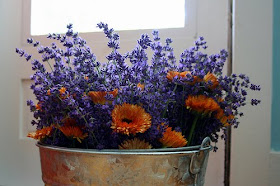Picture by mindwhisperings
The fragrance of lavender flowers is best between first corolla opens until all corollas shrivel. The more corollas shrivel the fragrance gets weaker, because there is less flowers despite of some fragrance is in the stems. The fragrance is the most intense when ¾ of the flowers on the stem are open.
In order to harvest lavender at proper time, some basic knowledge on anatomy of the lavender flowers and the natural process of ripening is needed. Each tiny lavender flower consists of the base called calyx that comes first and then opening corolla.
Corolla is the whorl of petals of a flower that collectively form an inner floral envelope or layer of the perianth, while calyx is the whorl of sepals (petals) of a flower collectively forming the outer floral envelope or layer of the perianth enclosing and supporting the developing bud; usually green. To complete the explanation perianth is collective term for the outer parts of a flower consisting of the calyx and corolla and enclosing the stamens and pistils (source of definitions Princeton.edu dictionary).
The process of opening and ripening the lavender flower is following:
- the calyxes show the violet color first,
- 1-2 corollas open,
- when the first corolla start to shrivel, more corollas start to open,
- the first corollas start to drop off and continue till you can see on the stem only lavender-grayish calyxes containing the early developing seeds.
For dried bunches – pick lavender stems when calyxes are fully colored and swollen – the easiest moment to decide “this is the day” – look for first open corolla.
For fresh bunches – pick lavender stems when few corollas are open (before any of them shrivels).
For sachets – for this purpose look of the flower is not important, so there is longer period for lavender harvesting. The period starts when first corolla opens, till first start to shrivel.
For heating pads – harvesting lavender same way as for sachets. For heating pads use same amounts of rice and lavender. Use mix of flowers and leaves for that purpose.
While cutting look where the new green growth starts and cut the stem just above it.
After rubbing the flowers off the stems, keep the stems – they still can be used for some aroma in the long winter days to resemble the beauty of summer. Lavender stems can be burned to get some fragrance or rubbed between the palms to help it to release remaining scent.
The Drunken Botanist: The Plants That Create the World's Great Drinks
Air-drying vs. dehydrator
The best way to dry lavender is to hang it in a warm place with no direct sunlight – although lavender flowers are sunlight resistant and don’t fade away, the temperature of sunlight may affect the amount of aroma left in the flowers. Heat speeds up the release of fragrance molecules from the plant, so drying it with dehydrator will remove some scent. I used this method on rose petals, that I use for making perfume and the result was very disappointing – no comparison with naturally drying petals.
There is no need to find special place for drying – make sure there is enough air circulation. I like to hang drying lavender stems in the places where I am passing by often in the day, or close to my desk – to get the beautiful scent while working.
Recommended reading:
17 Excellent Uses of Lavender
23 most beautiful lavender photos - hand picked
Top 10 most beautiful lavender fields photos - hand picked
***********************************
Ewa Szulc is the garden designer,
blogger and founder of the page EwaintheGarden.blogspot.com. She makes
beautiful gardens, offers garden coaching lessons and garden design to help you
to beautify your garden, make it healthier and organic. You can contact her at http://EwaintheGarden.blogspot.com
The Drunken Botanist: The Plants That Create the World's Great Drinks
If you don't want to miss next posts of Ewa in the Garden subscribe here:



Great info... understandably so, since lavender has cultivated for long, and the amount of research done. But the same thing applies to other plants, about the exact time to harvest, fruits or veggies. Lacking researched info, personal experience helps.
ReplyDeletehave a great weekend,
~bangchik
I read this post with great interest Ewa as I have a lot of lavender in my garden....I always hang it in the shed and use it in winter for the fire. Some years I make the scented bags and some years I am too lazy! I hope you are enjoying the weekend, xv.
ReplyDeleteBangchick, you are so right - sometimes it is so difficult to decide whether things we want to harvers are mature enough or not...
ReplyDeleteVicki, I remember your lavender in your garden so well - this is one of the most beautiful arrangements I saw.
ReplyDeleteI am in the process of adding more lavender in my garden right now :)
Happy Sunday!
Hi Ewa, thanks for this lovely post on Lavender. I've just returned from a holiday in France where they are very much into Lavender as you know.
ReplyDeleteYolanda XXX
Thank you for all those informations. Soon the lavender is going to bloom here. I am looking forward to it. After the rose perfume comes the lavender scent! I always cut it for sachets and the steems for burning in winter.
ReplyDeleteEnjoy your summer garden, Ewa!
Barbara